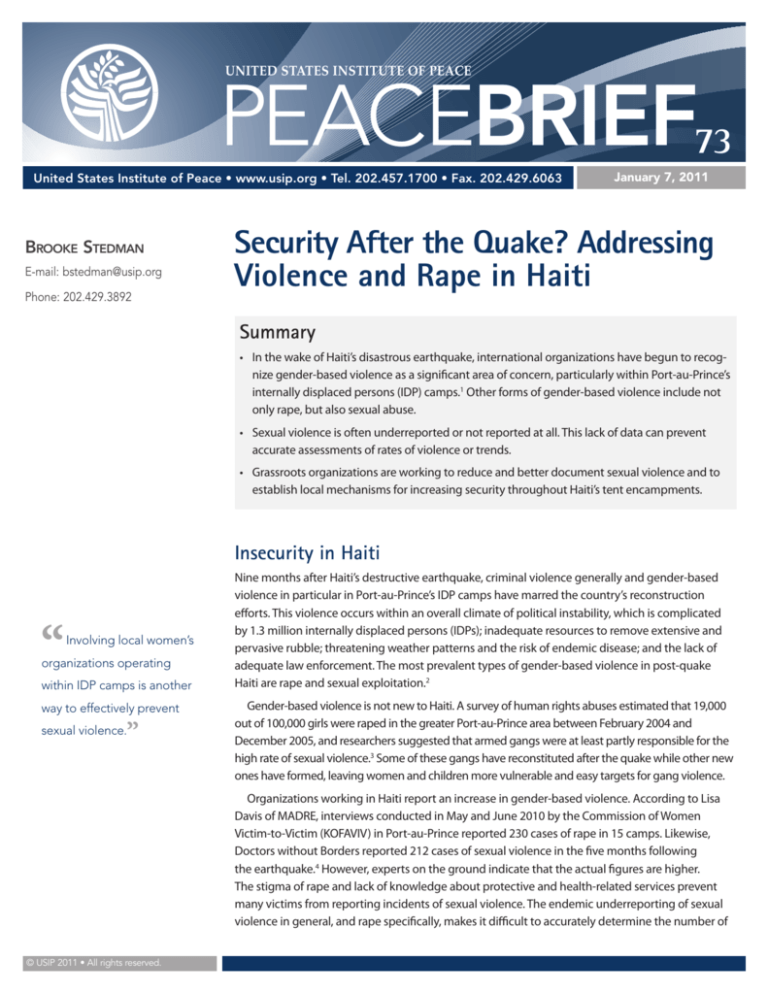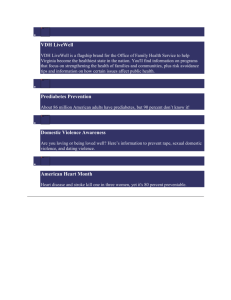
UNITED STates institute of peace
peaceBrieF73
United States Institute of Peace • www.usip.org • Tel. 202.457.1700 • Fax. 202.429.6063
Brooke Stedman
E-mail: bstedman@usip.org
Phone: 202.429.3892
January 7, 2011
Security After the Quake? Addressing
Violence and Rape in Haiti
Summary
• In the wake of Haiti’s disastrous earthquake, international organizations have begun to recognize gender-based violence as a significant area of concern, particularly within Port-au-Prince’s
internally displaced persons (IDP) camps.1 Other forms of gender-based violence include not
only rape, but also sexual abuse.
• Sexual violence is often underreported or not reported at all. This lack of data can prevent
accurate assessments of rates of violence or trends.
• Grassroots organizations are working to reduce and better document sexual violence and to
establish local mechanisms for increasing security throughout Haiti’s tent encampments.
Insecurity in Haiti
“
Involving local women’s
organizations operating
within IDP camps is another
way to effectively prevent
”
sexual violence.
Nine months after Haiti’s destructive earthquake, criminal violence generally and gender-based
violence in particular in Port-au-Prince’s IDP camps have marred the country’s reconstruction
efforts. This violence occurs within an overall climate of political instability, which is complicated
by 1.3 million internally displaced persons (IDPs); inadequate resources to remove extensive and
pervasive rubble; threatening weather patterns and the risk of endemic disease; and the lack of
adequate law enforcement. The most prevalent types of gender-based violence in post-quake
Haiti are rape and sexual exploitation.2
Gender-based violence is not new to Haiti. A survey of human rights abuses estimated that 19,000
out of 100,000 girls were raped in the greater Port-au-Prince area between February 2004 and
December 2005, and researchers suggested that armed gangs were at least partly responsible for the
high rate of sexual violence.3 Some of these gangs have reconstituted after the quake while other new
ones have formed, leaving women and children more vulnerable and easy targets for gang violence.
Organizations working in Haiti report an increase in gender-based violence. According to Lisa
Davis of MADRE, interviews conducted in May and June 2010 by the Commission of Women
Victim-to-Victim (KOFAVIV) in Port-au-Prince reported 230 cases of rape in 15 camps. Likewise,
Doctors without Borders reported 212 cases of sexual violence in the five months following
the earthquake.4 However, experts on the ground indicate that the actual figures are higher.
The stigma of rape and lack of knowledge about protective and health-related services prevent
many victims from reporting incidents of sexual violence. The endemic underreporting of sexual
violence in general, and rape specifically, makes it difficult to accurately determine the number of
© USIP 2011 • All rights reserved.
Security After the Quake? Addressing Violence and Rape in Haiti
page 2 • PB 73 • January 7, 2011
rapes that have occurred since the quake. Recognizing this fact, the Lawyer’s Earthquake Response
Network (LERN) surveyed Port-au-Prince IDP camp residents from May 1 to May 10, 2010. A large
majority of the rape victims interviewed did not seek medical help because they feared retaliation
or being ostracized. Most had no knowledge of where to find services.
Initially, international reconstruction efforts focused elsewhere, including on the elections held
on November 28, 2010. Only recently has the United Nations acknowledged that gender-based
violence and criminal violence are serious problems and impediments to long-term reconstruction
in Haiti. The UN has launched a campaign against rape and gender-based violence, which includes
training police and soldiers from the UN peacekeeping mission (MINUSTAH) and the Haitian
National Police (HNP), launching a public information campaign on medical services available for
the prevention of and response to rape, and deploying a 200-strong UN police unit to maintain
a permanent presence in six high-risk camps and patrols in 70 other priority camps. While these
efforts represent a significant improvement, questions have been raised as to how such a small
force can adequately support and protect a combined camp population at least 675 times its size.5
Local Action Addressing Gender-Based Violence
By engaging available resources and building upon existing networks, local Haitian women’s
organizations likewise are working to curb violence and establish security. Haitian women have
engaged the National Coalition against Gender-based Violence to aid their efforts. Led by the
Ministry of Women’s Status and Rights of Women, the National Coalition has partnered with
ministries, non-governmental organizations (NGOs), and international agencies to promote coordination between government, grassroots organizations and the international community. One
such partnership is between LERN, KOFAVIV, the Institute for Justice and Democracy in Haiti (IJDH)
and the Bureau des Avocats Internationaux (BAI). In response to the information gathered in the
LERN survey, IJDH and BAI joined with other grassroots groups in Haiti and international partners
to launch the Haiti Rape Accountability and Prevention Project (RAPP) to provide legal services to
victims of sexual assault. RAPP also addresses specific sources of insecurity in the camps, including
the lack of private or any shelter, lighting, and health facilities.6
Because shower and bathroom facilities are often located apart from the camps in more secluded
areas, women find themselves isolated and therefore more vulnerable to sexual violence, including
gang rapes and sexual assault. Inadequate lighting also leaves camp residents more vulnerable. Additionally, women walk long, unprotected distances to find clean water. Organizations have responded
to these vulnerabilities in some innovative ways. The International Organization for Immigration
has distributed 30,000 solar flash flights and coordinated with the U.S. Agency for International
Development to set up diesel generators to support pole lights. KOFAVIV has established volunteer
security patrols and has begun escorting women at night to the showers. In Champ de Mars, KOFAVIV
organized a security system with members inside the camp and noted a decrease in rape. Thousands
of whistles have been distributed by KOFAVIV, which has trained women to respond to whistles when
they were blown three times. Reports indicate that, in those camps trained in the whistle alert system,
perpetrators were frightened away and therefore the incidence of sexual violence decreased.
Steps to Prevent Gender-Based Violence
The UN secretary-general recently called for bringing perpetrators of gender-based violence to
justice, thus confronting the impunity that typifies gender-based violence in Haiti. In addition, the
secretary-general recommends directly involving Haitian women in security decisions that affect their
daily lives, as well as improving the current lack of coordination between international and grassroots
© USIP 2011 • All rights reserved.
Security After the Quake? Addressing Violence and Rape in Haiti
page 3 • PB 73 • January 7, 2011
About This Brief
This report is based on views
expressed during an August 31,
2010, event, “Security after the
Quake? Addressing Violence and
Rape in Haiti,” hosted by the U.S.
Institute of Peace’s Gender and
Peacebuilding Center and the
Haiti Working Group. The event
featured presentations by Robert
Perito, director of the Haiti Program, U.S. Institute of Peace; Lina
Abirafeh, former gender-based
violence coordinator, UN Humanitarian Response Depot (UNHRD);
Lisa Davis, advocacy director,
MADRE; and Louis-Alexander
Berg, Jennings-Randolph Peace
Scholar and rule of law adviser,
U.S. Agency for International
Development (USAID). Kathleen
Kuehnast, director of the Gender
and Peacebuilding Center, U.S.
Institute of Peace, served as
moderator. Brooke Stedman,
program assistant for the Gender
and Peacebuilding Center, wrote
the report.
organizations.7 UN Security Council Resolution 1325 mandates, and UN guiding principles on displacement strongly recommend, the involvement of women in decision making. Involving local women’s
organizations operating within IDP camps is another way to effectively prevent sexual violence, as
these groups can accurately assess problems in a timely way and identify solutions.
Networks for a grassroots response to gender-based violence are in operation but typically lack
coordination. Coordination is also lacking between local actors and international organizations.
The lack of support services, the absence of law and order, and the overall breakdown of community networks all play a significant role in contributing to the underlying insecurity as well as
the increase in gender-based violence in post-quake Haiti. Kathleen Kuehnast, director of USIP’s
Gender and Peacebuilding Center, summed up the urgency of coordinated action: “Without these
actions, Haiti will be shaken again. This time it will not be about destroyed buildings but about the
devastation of the social fabric of Haiti, one of the most essential ingredients for reconstruction.”8
Conclusion
The international community is aware of the obstacles in Haiti’s post-quake reconstruction and
the need for both short- and long-term solutions. Recent studies by local organizations report
an increase in gender-based and criminal violence, highlighting the sources of instability and
identifying viable solutions. Haitian grassroots organizations face an uphill battle as they work with
inadequate resources to curb violence in the face of instability and insecurity. Despite the severity
of Haiti’s challenges in reconstruction, the small successes of these local organizations in reducing
violence provide a model for international NGOs to follow. Additionally, the proactive role of local
Haitian organizations working in the IDP camps to reduce gender-based violence exemplifies the
effective interventions that can be made when women are included in reconstruction efforts.
Endnotes
1. World Health Organization (WHO). “Sexual and other forms of gender-based violence in crises.”
http://www.who.int/hac/techguidance/pht/SGBV/en/index.html
2. Presto, Suzanne. “Sexual Assaults in Haitian Camps Prompt Security Enhancements.” Washington, D.C.: Voice of America, March 22, 2010.
3. Athena R. Kolbe and Royce A. Houston, “Human rights abuse and other criminal violations in
Port-au-Prince, Haiti: a random survey of households.” The Lancet, Volume 368 (2006): 868.
4. Institute for Justice and Democracy in Haiti, MADRE, University of Virginia Law School, TransAfrica Forum, and the University of Minnesota Human Rights Litigation and Advocacy Clinic. “Our
Bodies are Still Trembling: Haitian Women’s Fight Against Rape.” (July 2010): 1-43.
5. In a September 2010 report from the Institute for Justice and Democracy in Haiti, the head of
MINUSTAH, Ambassador Edmond Mulet, described the situation: “Institutional weakness, combined with the displaced persons camps, the resurgence of gang activity and the characteristic
instability of the Haitian electoral season contribute to creating a volatile security environment.”
USIP provides the analysis, training and
tools that prevent and end conflicts,
promotes stability and professionalizes
the field of peacebuilding.
For media inquiries, contact the office
of Public Affairs and Communications,
202.429.4725
6. Michel Forst, the UN independent expert on the human rights situation in Haiti, identified
these sources of insecurity.
7. Secretary-General Ban Ki-Moon. “Study on Violence Against Women.” 61st Session of the
General Assembly Item 60(a) on Advancement of Women. United Nations, forthcoming 2010.
A/61/122/Add. Para. 1.
8. Interview with Kathleen Kuehnast, August 31, 2010.
© USIP 2011 • All rights reserved.










